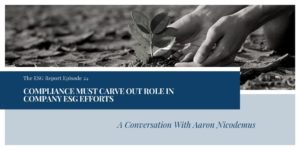
Aaron Nicodemus has been a reporter for over 30 years in the US and South Africa, having written for various notable publications including Bloomberg. He has been a writer/reporter at Compliance Week for the last 18 months. He is Tom Fox’s guest this week on the ESG Report. They discuss his recent article about the intersection of ESG and compliance, entitled “Compliance Must Carve Out Role in Company ESG Efforts.”
Inside the Mind of the CCO Survey
“Every year for the past three years Compliance Week has conducted an Inside the Mind of the CCO survey,” Aaron tells Tom. This year the focus was on ESG since it has been a hot topic, and they wanted to gauge what ESG initiatives looked like across industries and organizations. “Almost all of the compliance officers who took the survey felt that compliance should be involved in ESG initiatives at their company,” Aaron reveals. CCOs believe that compliance is best positioned to lead ESG since it intersects with so many of their core functions. “Putting [compliance] in charge of the ESG initiatives would help make sure that [the company] meets all the regulations that they should, and also that they are reporting on data that is both accurate and informative,” he comments. Now that the SEC is poised to issue new mandates regarding climate change disclosures, compliance will most likely have to be front and center for ESG going forward. “When regulators get involved that tends to push compliance to the fore,” Aaron remarks.
Key Findings
Tom and Aaron discuss some key findings outlined in the article. These include:
- The actual role of CCOs in ESG – 73% of CCOs have an active role in ESG, either as advisor, primary overseer, or advocate.
- Where they see their role – 23% of CCOs feel they should have more oversight over ESG than they currently have. Most persons surveyed feel that compliance should have a prominent role in ESG.
- Whether compliance should lead all 3 aspects of ESG – Most CCOs see governance as their core function, while environmental and social concerns are secondary roles.
- Compliance is the conscience of the company.
- Stakeholders are demanding more information on ESG to influence their investment decisions.
Growth of ESG
Tom sees ESG as the fastest moving corporate initiative. He asks Aaron if the survey confirms this view. “It’s been a gradual process that has come to a head in Europe and in the UK,” Aaron responds. Similar climate change disclosure mandates are likely to happen in the US in 2022. Companies have been pursuing sustainability and D&I initiatives for several years. “ESG collects up some of those things in a tight little bundle, and you can really pursue a lot of issues under the ESG umbrella,” he continues. He sees ESG accelerating over the next few years, starting with climate change.
Resources
Aaron Nicodemus on LinkedIn | Twitter | Email
Compliance Week: Compliance Must Carve Out Role in Company ESG Efforts






